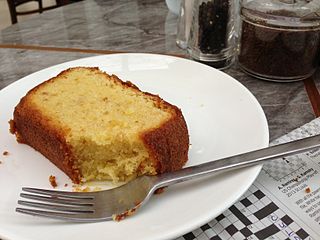
Vermicelli is a traditional type of pasta round in section similar to spaghetti. In English-speaking regions it is usually thinner than spaghetti, while in Italy it is thicker.

The mung bean, alternatively known as green gram, mungo bean or mongo bean, is a plant species in the legume family. The mung bean is mainly cultivated in East, Southeast and South Asia. It is used as an ingredient in both savoury and sweet dishes.

Chinese noodles vary widely according to the region of production, ingredients, shape or width, and manner of preparation. Noodles were invented in China, and are an essential ingredient and staple in Chinese cuisine. They are an important part of most regional cuisines within China, and other countries with sizable overseas Chinese populations.

Misua, also known as wheat vermicelli, is a very thin variety of salted noodles made from wheat flour. It originated in Fujian, China. The noodles differ from mifen and cellophane noodles in that those varieties are made from rice and mung beans, respectively.

Northeastern Chinese cuisine is a style of Chinese cuisine in Northeast China. While many dishes originated from Shandong cuisine and Manchu cuisine, it is also influenced by the cuisines of Russia, Beijing, Mongolia, and North Korea. It partially relies on preserved foods and large portions due to the region's harsh winters and relatively short growing seasons.

Cellophane noodles, or fensi, sometimes called glass noodles, are a type of transparent noodle made from starch and water. A stabilizer such as chitosan may also be used.

Pancit, also spelled pansít, is a general term referring to various traditional noodle dishes in Filipino cuisine. There are numerous types of pancit, often named based on the noodles used, method of cooking, place of origin, equal and constant diameter or the ingredients. Most pancit dishes are characteristically served with calamansi, which adds a citrusy flavor profile.

Japchae is a savory and slightly sweet dish of stir-fried glass noodles and vegetables that is popular in Korean cuisine. Japchae is typically prepared with dangmyeon, a type of cellophane noodles made from sweet potato starch; the noodles are mixed with assorted vegetables, meat, and mushrooms, and seasoned with soy sauce and sesame oil.

Rice vermicelli is a thin form of noodle. It is sometimes referred to as "rice noodles" or "rice sticks", but should not be confused with cellophane noodles, a different Asian type of vermicelli made from mung bean starch or rice starch rather than rice grains themselves.

Kal-guksu is a Korean noodle dish consisting of handmade, knife-cut wheat flour noodles served in a large bowl with broth and other ingredients. It is traditionally considered a seasonal food, consumed most often in summer. Its name comes from the fact that the noodles are not extruded, pulled, or spun, but cut.

Mung bean sprouts are a culinary vegetable grown by sprouting mung beans. They can be grown by placing and watering the sprouted beans in the shade until the hypocotyls grow long. Mung bean sprouts are extensively cultivated and consumed in East and Southeast Asia and are very easy to grow, requiring minimal care other than a steady supply of water. They are often used in school science projects.

Douzhi is a fermented dish from Beijing cuisine. It is similar to soy milk, but made from mung beans. It is a by-product of cellophane noodle production. It is generally slightly sour, with an rotten egg-like smell.

Liangfen, also spelled liang fen, is a Chinese legume dish consisting of starch jelly that is usually served cold, with a savory sauce, often in the summer. It is most popular in northern China, including Beijing, Gansu, and Shaanxi, but may also be found in Sichuan and Qinghai. In Tibet and Nepal it is called laping and is a common street vendor food. In Kyrgyzstan it is an ingredient in a noodle dish called ashlan fu.
Korean regional cuisines are characterized by local specialties and distinctive styles within Korean cuisine. The divisions reflected historical boundaries of the provinces where these food and culinary traditions were preserved until modern times.

Ageh or Tamsui ageh is a speciality food originating from Tamsui District of New Taipei City and consists of a piece of fried tofu, stuffed with cooked Cellophane noodles, and sealed with surimi, which is widely sold by vendors in the district. The name ageh was derived from aburaage, a fried and stewed Japanese tofu packet from which the ageh is made.

The Eurasian cuisine of Singapore and Malaysia is a type of fusion cuisine.

Laghman is a dish of meat, vegetables and pulled noodles from Uyghur cuisine and Central Asian cuisine. In Chinese, the noodle is known as latiaozi or bànmiàn.
















